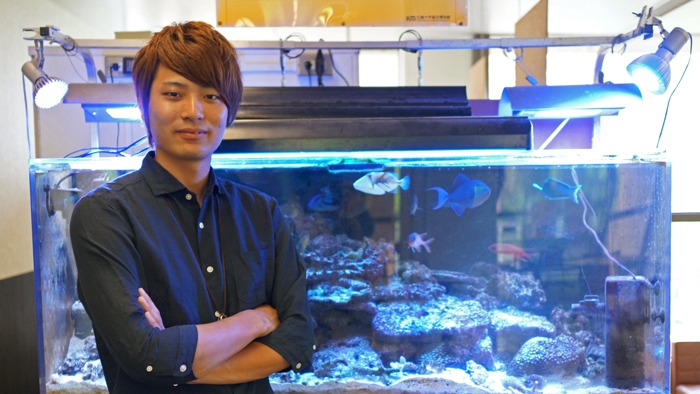
3rd year, Fisheries Biology Program, Faculty of Applied Biological Science
Naoki Onimura
<Graduated from Hiroshima Municipal Asakita Senior High School>
Mr. Onimura entered the Faculty of Applied Biological Science because he loves nature and wanted to research about fish. He is enjoying his studies along with friends that also love animals. For extracurricular activities, he is also working on hosting nature experience activities for parents and children. We interviewed him about why he decided to apply to this faculty and his campus life.
Please tell us why you decided to apply for Hiroshima University’s Faculty of Applied Biological Science
Fishing was my hobby from when I was a child. I heard about Hiroshima University’s Faculty of Applied Biological Science when I was a second year student in junior high school. When I looked at the homepage, I saw a photograph about catching fish and conducting research. I thought if my hobby could also be the subject of my studies and research, I would be very happy. The more I found out about this faculty, the more it appealed to me. Ever since then, my dream was to enter Hiroshima University and research about fish.
Wow! Your dream since junior high school! What was appealing to you about the Faculty of Applied Biological Science?
From junior high school and now, I have been following Professor Takeshi Naganuma on the media. I like how he is running the forefront of this time. I also felt the materials I will be learning in this faculty directly connected to solving big problems like food issues and global warming.
My older sister that went to Hiroshima University also had influence on me. I saw how she was taking part in many activities and I could sense the free atmosphere of this university. I was attracted to not only the Faculty of Applied Biological Science, but to the university as a whole. I admire university towns and for someone that loves nature like me, I felt Higashi Hiroshima campus in Saijo was the perfect place for me to live. I liked everything about Hiroshima University and really wanted to study here.
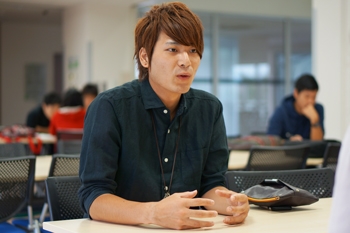
Mr. Onimura says “I wanted to go to Hiroshima University since I was a junior high school student”
You entered through the AO entrance examination. How did you study for it?
I bought and studied a few textbooks used in the Faculty of Applied Biological Science. I also participated in mock lessons of the Faculty of Applied Biological Science and Hirameki Tokimeki Science* (Welcome to a University Research Lab-Science that inspires and inspirits). By participating in research with the university and research institutes, I was even more motivated. I used this experience in my AO entrance examination.
* This program allows elementary to high school students to actually see, hear, and feel leading research done in research institutes to inspire them about Science. Sponsored by the Japan Society for the Promotion of Science (JSPS)
Were you also studying for the General Entrance Exam?
Yes, in case I wasn’t accepted through the AO entrance exam. It was hard studying for the AO entrance exam and the General Entrance Exam at the same time, but I kept my motivation high by imagining my life after entering university.
So you admired Hiroshima University so much. How was it after entering the university?
100 points!
I am so happy for you! What do you like about Hiroshima University?
Hiroshima University has great research facilities and a great school system. I am pleased that the university helps out students in their extra curricular activities too, not just in classes and research.
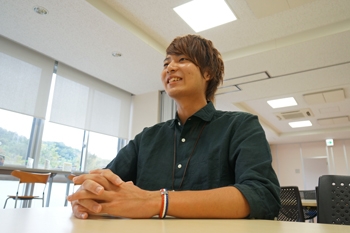
Mr. Onimura says “100 points” with a big smile
What are you currently learning about?
I am learning about the marine products industry economy, and the ecosystem and behavior of aquatic organisms that are part of the fishing industry. I am also researching about diseases and parasites of breeding fishes.
What are you particularly interested in?
I am thinking about researching about non-native benthic organisms like shellfish and shrimp. I am planning to conduct my research at the local Kurose river estuary. There are many things we still do not understand about non-native organisms. I want to research about how non-native organisms affect other organisms and how their habitat may change depending on the season.
What is fun about your classes?
Hands down, the amount of field works! I wouldn’t be exaggerating to say, it’s the best part about my faculty. Most people have an image that research is inside a laboratory. But for our fieldwork, we go into nature and learn while catching living things. Recently, I experienced a 9-day training aboard a ship. I love learning with people that also love animals like me.
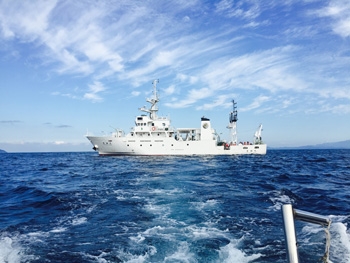
The ship we went on for training
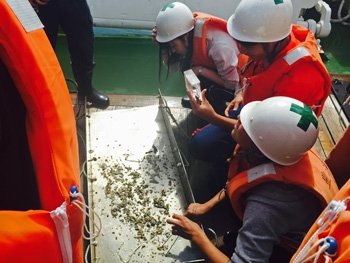
Bed material investigation during the training
You have such a happy expression! What is your week like?
My weekday schedule is busy from morning to evening. I have classroom lectures from morning to noon and training after noon. After school, I participate in extracurricular activities or go to my part-time job. I work at a fishing equipment shop and tutor at a cram school.
What kinds of extra curricular activities do you participate in?
During my first and second year of university, I was a volunteer member for reconstructing the areas affected by the Great East Japan earthquake. I learned many things and the activities were very fulfilling, but I started to think, “What can I do in Hiroshima?” and “Can I do any activities to share what I am learning in class?” When I was about to become a third grade student, I made a group called Team Onagobata with members from my faculty and now I am concentrating my efforts here. I feel it is a waste not to use what we learn in class, and we should use that knowledge to contribute to the community.
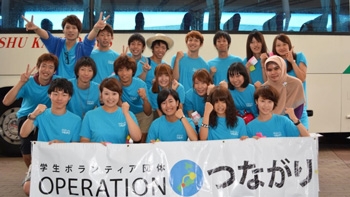
Volunteer members that helped to reconstruct after the Great East Japan Earthquake
What kinds of activities does “Team Onagobata” plan?
Our main activity in the beginning was farming abandoned fields in Hiroshima with people that have been affected by the Great East Japan earthquake and evacuated to Hiroshima. Then we thought we want more children to learn about nature around us. So we started to hold environment study activities with children in the community. Now, we hold more environment study activities for parents and children. We want not only children, but also parents to learn how to play in nature because we want them to eventually play in nature without needing to join these events.
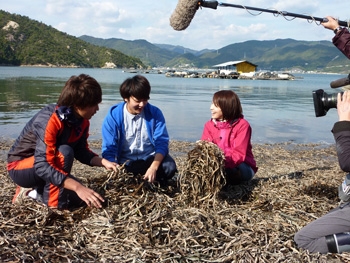
“Team Onagobata” members being interviewed by the television station
What do you do in these environment study activities?
We ask participants to observe tidal flats and uninhabited islands and experience nature. In the most recent environmental study activity, we went to a deserted island in the Seto Inland Sea called Kashiwa Island by sea kayaks. At Kashiwa Island, we climbed a mountain, caught fish and other living things, and made a photo frame with seashells that we picked up there. We put the living organisms that we caught in a water tank at “Marugoto Aquarium” (Kure city hotel: Green Pia Setouchi) and asked the children to draw pictures of the animals.
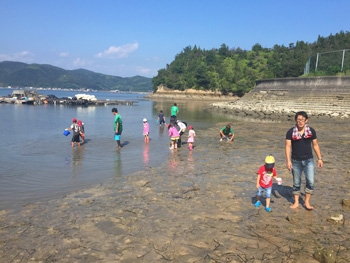
Tidal flats observation activity with 10 parent and child teams
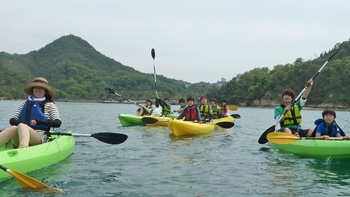
Sea kayak experience
What is “Marugoto Aquarium”?
“Marugoto Aquarium” was suggested by Kure city public welfare organization, Team JIN. It is one of the 2015 Community Contribution Researches of Hiroshima University.
This aquarium exhibits fish from the Seto Inland Sea with the theme of environment study and food education. The fun part about this aquarium is that you can put fish that you caught yourself inside the fish tanks. There is also a quiz corner that we created.
*Project Theme “Formalization and Implementation of environmental preservation activities and nature experience study programs for parent and child in Satoumi** areas”
Satoumi** is defined as marine and coastal landscapes that have been formed and maintained by prolonged interaction between humans and ecosystems.
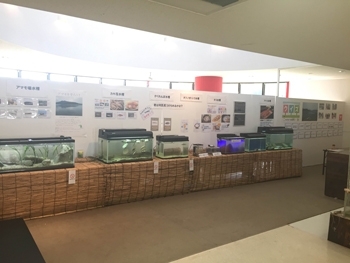
”Marugoto Aquarium”
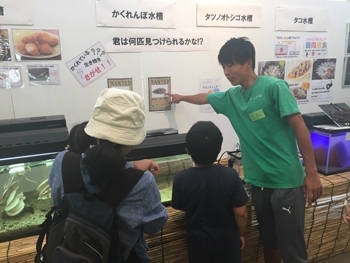
Quiz Corner
I hope many children will come! What are your future goals?
I want to become a government employee having to do with the fisheries. I want to continue to participate in activities that connect nature and people, especially children and nature.
Please give a message to “Future Hiroshima University students” that are thinking of applying to Hiroshima University!
I can recommend Hiroshima University with confidence. It must hard studying for the entrance examinations now, but you can do it! Try to imagine all the things you want to do after entering the university. I will be waiting at Hiroshima University with fish!
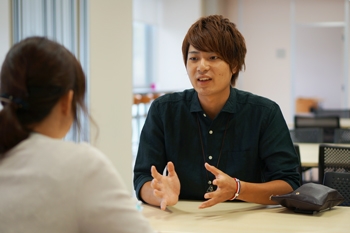
September 17, 2015
Reports: Public Relations Group (F)
Photograph: Public Relations Group (i)
Location: Faculty of Applied Biological Science Lobby, Student Plaza


 Home
Home





